Terry Odell's Blog, page 253
May 3, 2012
I've Moved!
It's official. Terry's Place has a new address. Please bookmark the new site. http://terryodell.com/terrysplace. To celebrate, I'm going to have a new contest with a Really Big Prize. Details will be announced over there in the very near future.
Posts on this blog will stay here, but I hope you'll visit my new site and subscribe to posts over there.
Posts on this blog will stay here, but I hope you'll visit my new site and subscribe to posts over there.
Published on May 03, 2012 17:39
May 1, 2012
Terry's Place is moving
First, thanks to Bailey for yesterday's post. I remember Maypole dancing when I was in grade school.
After over four years here, Terry's Place is moving. Although I'd been thinking about it for some time, the recent lack of support and customer service from Blogger has lit a fire under the move. I hope you'll bookmark my new site, and continue to follow. Because I'm moving sooner than I'd planned, the new site is still in transition, and as I learn more about the features, I'll add them. Feel free to make suggestions.
Some things I'm looking forward for: threaded comments, so we can carry out some discussions in the comments. Also, leaving a comment will require that you give an email address. I PROMISE that these will NEVER be shared. But what it will mean is that I'll have an easier way to let you know when you've won a contest. (For those of you who have left comments on yesterdays posts, I'll be posting Bailey's winner on Saturday at the new site. Her post is echoed over there as well.) Remember, you have until Friday to comment to enter.
Also, if anyone here is conversant in WordPress and wants to suggest widgets or plugins (I've learned some new terminology), feel free to give a shout out! I know Google Friend Connect isn't available for non-Blogger sites, but I hope you'll add the new site to however you follow blogs.
And, my new site will continue to do everything I've done here. That means that because it's Wednesday, there's a recipe, thanks to frequent contributor here, Karen C. To celebrate the first official blog, it's strawberry shortcake cookies!
Head over there now, and say hello. Here's the link: http://terryodell.com/terrysplace. And this site will remain available, so you won't lose any links or posts you've bookmarked.
After over four years here, Terry's Place is moving. Although I'd been thinking about it for some time, the recent lack of support and customer service from Blogger has lit a fire under the move. I hope you'll bookmark my new site, and continue to follow. Because I'm moving sooner than I'd planned, the new site is still in transition, and as I learn more about the features, I'll add them. Feel free to make suggestions.
Some things I'm looking forward for: threaded comments, so we can carry out some discussions in the comments. Also, leaving a comment will require that you give an email address. I PROMISE that these will NEVER be shared. But what it will mean is that I'll have an easier way to let you know when you've won a contest. (For those of you who have left comments on yesterdays posts, I'll be posting Bailey's winner on Saturday at the new site. Her post is echoed over there as well.) Remember, you have until Friday to comment to enter.
Also, if anyone here is conversant in WordPress and wants to suggest widgets or plugins (I've learned some new terminology), feel free to give a shout out! I know Google Friend Connect isn't available for non-Blogger sites, but I hope you'll add the new site to however you follow blogs.
And, my new site will continue to do everything I've done here. That means that because it's Wednesday, there's a recipe, thanks to frequent contributor here, Karen C. To celebrate the first official blog, it's strawberry shortcake cookies!
Head over there now, and say hello. Here's the link: http://terryodell.com/terrysplace. And this site will remain available, so you won't lose any links or posts you've bookmarked.
Published on May 01, 2012 11:59
Happy Beltane!
Bailey Cates writes the Magical Bakery Mysteries. The first in the series, Brownies and Broomsticks, releases today in mass market paperback and ebook formats from NAL/Penguin. She also writes the Home Crafting Mystery Series as Cricket McRae. The sixth in that series, Deadly Row to Hoe, will release in November from Midnight Ink/Llewellyn. There's a giveaway, so be sure to leave a comment. And check back this weekend to see if you won.

Thanks for inviting me to guest here at Terry’s Place! I’m delighted to stop by, especially as today is Beltane, or May Day, which I’ve decided is a rather auspicious release date for my first paranormal cozy mystery.
When I was a little girl we made up little paper “vases” and filled them with spring flowers early in the morning on the first of May. Then I went around the neighborhood and hung them on all the doorknobs. I loved this annual event, but had no idea what May Day was supposed to be about beyond surreptitious flower deliveries. Since writing about a hedge witch – or green witch – I’ve learned a lot more about this holiday.
May 1st, or May Day, falls halfway between the spring equinox and the summer solstice. Like Samhain (Halloween), it’s supposed to be a time when the veils of the two worlds are at their thinnest. Fairies come back into the warming world, led by their queen on a white horse and bring with them plenty of magic and mischief. Rowan branches on the windowsill are a traditional protection against their antics.
On a more practical level, Beltane celebrates passing into a season of growth – and renewed foodstuffs. In a world before you could just pop into the local megamart to pick up some out-of-season produce, the early greens and fresh foods were more than welcome after a long winter of tubers and roots – or worse. Flowers bloom, the trees turn green, and the promise of spring is finally realized on your dinner plate.
The celebration of Beltane often involves a bonfire. Bel is the Celtic Sun God, and “Beltane” translates from the Anglo Saxon as “Bel Fire”. On this day fires in village homes were extinguished and then relit from the central bonfire/belfire.
In agrarian cultures farmers would build two bonfires and lead animals between them to increase fertility. Circling the Beltane bonfire three times deosil (clockwise) is said to bring good luck.
Along with fire, flowers are an important symbol of May Day. In fact the first May Days were Roman rather than Celtic. They celebrated Flora, the goddess of flowers. Wreaths and garlands are typical decorations for Beltane.
You may be also be familiar with the modern traditions of girls dancing around the maypole on May Day and communities crowning a May Queen. Sometime a mummer – someone who acts entirely in pantomime – in the character of Jack the Green (also known as The Green Man) may dance around the maypole, too, along with another mummer known only as the Fool. And you can still find Morris dancers – recorded in England as early as 1555 – frolicking with them. However, Morris dancers apparently weren’t associated with English May Day celebrations until the reign of the Tudors.
As for those paper vases of flowers I used to hang on my neighbors’ door knobs? Turns out that probably originated as offering to the fairies for good luck. Making the offering for your neighbors was an act of kindness. Who knew?
Thanks again, Terry!
This year, Bailey is celebrating Beltane by giving away a copy of Brownies and Broomsticks. Just leave a comment to enter. For more information about her or either of her mystery series, please check out her website at www.cricketmcrae.com , or either of her blogs at www.hearthcricket.com or www.baileycates.com.
Like this post? Please share by clicking one of the links below.

Thanks for inviting me to guest here at Terry’s Place! I’m delighted to stop by, especially as today is Beltane, or May Day, which I’ve decided is a rather auspicious release date for my first paranormal cozy mystery.
When I was a little girl we made up little paper “vases” and filled them with spring flowers early in the morning on the first of May. Then I went around the neighborhood and hung them on all the doorknobs. I loved this annual event, but had no idea what May Day was supposed to be about beyond surreptitious flower deliveries. Since writing about a hedge witch – or green witch – I’ve learned a lot more about this holiday.
May 1st, or May Day, falls halfway between the spring equinox and the summer solstice. Like Samhain (Halloween), it’s supposed to be a time when the veils of the two worlds are at their thinnest. Fairies come back into the warming world, led by their queen on a white horse and bring with them plenty of magic and mischief. Rowan branches on the windowsill are a traditional protection against their antics.
On a more practical level, Beltane celebrates passing into a season of growth – and renewed foodstuffs. In a world before you could just pop into the local megamart to pick up some out-of-season produce, the early greens and fresh foods were more than welcome after a long winter of tubers and roots – or worse. Flowers bloom, the trees turn green, and the promise of spring is finally realized on your dinner plate.
The celebration of Beltane often involves a bonfire. Bel is the Celtic Sun God, and “Beltane” translates from the Anglo Saxon as “Bel Fire”. On this day fires in village homes were extinguished and then relit from the central bonfire/belfire.
In agrarian cultures farmers would build two bonfires and lead animals between them to increase fertility. Circling the Beltane bonfire three times deosil (clockwise) is said to bring good luck.
Along with fire, flowers are an important symbol of May Day. In fact the first May Days were Roman rather than Celtic. They celebrated Flora, the goddess of flowers. Wreaths and garlands are typical decorations for Beltane.
You may be also be familiar with the modern traditions of girls dancing around the maypole on May Day and communities crowning a May Queen. Sometime a mummer – someone who acts entirely in pantomime – in the character of Jack the Green (also known as The Green Man) may dance around the maypole, too, along with another mummer known only as the Fool. And you can still find Morris dancers – recorded in England as early as 1555 – frolicking with them. However, Morris dancers apparently weren’t associated with English May Day celebrations until the reign of the Tudors.
As for those paper vases of flowers I used to hang on my neighbors’ door knobs? Turns out that probably originated as offering to the fairies for good luck. Making the offering for your neighbors was an act of kindness. Who knew?
Thanks again, Terry!
This year, Bailey is celebrating Beltane by giving away a copy of Brownies and Broomsticks. Just leave a comment to enter. For more information about her or either of her mystery series, please check out her website at www.cricketmcrae.com , or either of her blogs at www.hearthcricket.com or www.baileycates.com.
Like this post? Please share by clicking one of the links below.
Published on May 01, 2012 03:59
April 30, 2012
Pikes Peak Writers Conference 3 - Series
What I'm Reading: Breaking the Rules, by Suzanne Brockmann; From the Ashes, by Jeremy Burns (Nook)
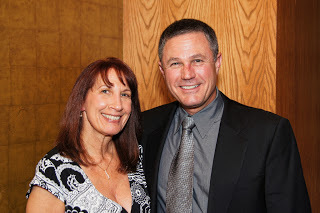 Okay, so the picture doesn't exactly evoke "series", although Robert Crais writes series, and so do I. Which hardly puts us in the same league. But he was on the series panel, and I was in the audience, so the picture sort of fits. Kind of. If you stretch the imagination. But he's easy on the eyes, so what the heck. It IS my blog, after all.
Okay, so the picture doesn't exactly evoke "series", although Robert Crais writes series, and so do I. Which hardly puts us in the same league. But he was on the series panel, and I was in the audience, so the picture sort of fits. Kind of. If you stretch the imagination. But he's easy on the eyes, so what the heck. It IS my blog, after all.
I'm trying to mix up the workshop topics so there's something for everyone. I'll still have more on publishing, and that 1875 forensics post, so keep coming back. And I'll mention again that Blogger is still not publishing my posts on schedule, so until they fix it (or I take the blog elsewhere), please bear with me if things show up later than usual. Much as I love you guys, getting up at 5 AM to hit "publish" isn't appealing.
I was especially interested in the panel on writing series. The authors on the panel were Carrie Vaughn, Jeffery Deaver, Joe Lansdale and Robert Crais.
These authors didn't set out to write series when they started. Like so many of us, they just wanted to get a book published. Crais confessed that in his outline (cringe!), he had planned to kill off Joe Pike, but when it came time to write the scene, he couldn't do it. And he's very glad he couldn't.
In writing series, it's important to keep details straight, although the authors had different ways of dealing with it. One said that one of his readers created and kept a Bible of his characters and plots. However, he confessed that he rarely looks at it anymore. Crais said his readers are quick to point out his continuity errors. All are grateful for the 'Search' function in word processing programs.
The authors agreed that they tended to minimize physical descriptions, which not only avoids the brown eyes turning blue, but also allows readers to create their own images of the characters.
Not only is it important to keep the characters' physical details straight, it's also important that the tone—the verbal quality—remain consistent. The characters need to think in the same way throughout the series (unless the plot dictates otherwise), to speak the same way, using the same expressions and catch phrases.
The panel also said they don't plot out character or plot arcs for several books in advance. They will get ideas while writing one book that they know will have to wait for the next book(s) to be addressed.
The discussion moved into talking about writing what readers want. Crais commented that he could create a poll and ask readers if Lucy and Elvis should get married, or if he should let Lucy be hit by a truck. He hypothesized that perhaps 60% might say, 'let them get married.' If he wrote that book, then those who wanted her hit by a truck wouldn't read it, and those who wanted her to get married would already know the ending, so they wouldn't read it either.
Lansdale said you can't think about readers when you're writing. You have to trust yourself. He also said that it's important to be a storyteller. He doesn't plot. (He said he wasn't smart enough to plot, at which point Crais interrupted and said he always thought he wasn't smart enough to write by the seat of his pants the way Lansdale does).
The entire panel agreed that what gives a series "legs" is the characters. It's their lives readers are following, and it's important to make sure they're three-dimensional.
The question of dealing with back story came up, and again, all agreed that less is better. As a matter of fact, even though I'm a stickler for dribbling in back story, after getting home and looking at my second Mapleton mystery, I realized I was introducing too many 'returning' characters and drastically tightened my first chapter.
Tomorrow, my guest is Bailey Cates, who's going to teach us all about Beltane.
Like this post? Please share by clicking one of the links below.
 Okay, so the picture doesn't exactly evoke "series", although Robert Crais writes series, and so do I. Which hardly puts us in the same league. But he was on the series panel, and I was in the audience, so the picture sort of fits. Kind of. If you stretch the imagination. But he's easy on the eyes, so what the heck. It IS my blog, after all.
Okay, so the picture doesn't exactly evoke "series", although Robert Crais writes series, and so do I. Which hardly puts us in the same league. But he was on the series panel, and I was in the audience, so the picture sort of fits. Kind of. If you stretch the imagination. But he's easy on the eyes, so what the heck. It IS my blog, after all. I'm trying to mix up the workshop topics so there's something for everyone. I'll still have more on publishing, and that 1875 forensics post, so keep coming back. And I'll mention again that Blogger is still not publishing my posts on schedule, so until they fix it (or I take the blog elsewhere), please bear with me if things show up later than usual. Much as I love you guys, getting up at 5 AM to hit "publish" isn't appealing.
I was especially interested in the panel on writing series. The authors on the panel were Carrie Vaughn, Jeffery Deaver, Joe Lansdale and Robert Crais.
These authors didn't set out to write series when they started. Like so many of us, they just wanted to get a book published. Crais confessed that in his outline (cringe!), he had planned to kill off Joe Pike, but when it came time to write the scene, he couldn't do it. And he's very glad he couldn't.
In writing series, it's important to keep details straight, although the authors had different ways of dealing with it. One said that one of his readers created and kept a Bible of his characters and plots. However, he confessed that he rarely looks at it anymore. Crais said his readers are quick to point out his continuity errors. All are grateful for the 'Search' function in word processing programs.
The authors agreed that they tended to minimize physical descriptions, which not only avoids the brown eyes turning blue, but also allows readers to create their own images of the characters.
Not only is it important to keep the characters' physical details straight, it's also important that the tone—the verbal quality—remain consistent. The characters need to think in the same way throughout the series (unless the plot dictates otherwise), to speak the same way, using the same expressions and catch phrases.
The panel also said they don't plot out character or plot arcs for several books in advance. They will get ideas while writing one book that they know will have to wait for the next book(s) to be addressed.
The discussion moved into talking about writing what readers want. Crais commented that he could create a poll and ask readers if Lucy and Elvis should get married, or if he should let Lucy be hit by a truck. He hypothesized that perhaps 60% might say, 'let them get married.' If he wrote that book, then those who wanted her hit by a truck wouldn't read it, and those who wanted her to get married would already know the ending, so they wouldn't read it either.
Lansdale said you can't think about readers when you're writing. You have to trust yourself. He also said that it's important to be a storyteller. He doesn't plot. (He said he wasn't smart enough to plot, at which point Crais interrupted and said he always thought he wasn't smart enough to write by the seat of his pants the way Lansdale does).
The entire panel agreed that what gives a series "legs" is the characters. It's their lives readers are following, and it's important to make sure they're three-dimensional.
The question of dealing with back story came up, and again, all agreed that less is better. As a matter of fact, even though I'm a stickler for dribbling in back story, after getting home and looking at my second Mapleton mystery, I realized I was introducing too many 'returning' characters and drastically tightened my first chapter.
Tomorrow, my guest is Bailey Cates, who's going to teach us all about Beltane.
Like this post? Please share by clicking one of the links below.
Published on April 30, 2012 04:00
April 27, 2012
Friday Field Trip - Where's Waldo?
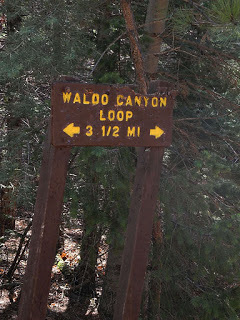 While I was busy with workshops at the Pikes Peak Writers Conference, Hubster went hiking in nearby Waldo Canyon. And I though when he'd said he wanted to come to the conference with me to do "Springs Things", I though he was talking about Costco or other places to stock up on things we can't find in Divide. But he did get pictures. Probably more than one Friday's worth.
While I was busy with workshops at the Pikes Peak Writers Conference, Hubster went hiking in nearby Waldo Canyon. And I though when he'd said he wanted to come to the conference with me to do "Springs Things", I though he was talking about Costco or other places to stock up on things we can't find in Divide. But he did get pictures. Probably more than one Friday's worth.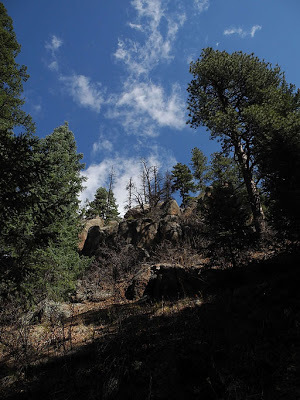






Like this post? Please share by clicking one of the links below.
Published on April 27, 2012 04:00
April 26, 2012
Pikes Peak Writers Conference 2 - Fingerprinting
What I'm reading: Free Fire, by C.J. Box; The Immortal Life of Henrietta Lacks, by Rebecca Skloot (book club)
Continuing with workshop recaps from the Pikes Peak Writers Conference.
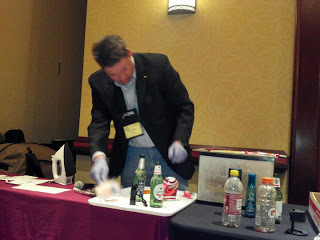 There were two workshops on forensics, both given by retired forensics expert, Tom Adair. (And, he's going to be my guest on May 8th). Both were "hands on" which made a great change from sitting and taking notes.
There were two workshops on forensics, both given by retired forensics expert, Tom Adair. (And, he's going to be my guest on May 8th). Both were "hands on" which made a great change from sitting and taking notes.
The first was about fingerprinting. (And although the workshop was hands on, he did begin with some facts.)
Fingerprints are unique and permanent (with very few exceptions, such as burns. They're established in the second trimester, pre-birth. In addition to fingerprints, all dermal ridge prints are unique to the individual (feet, toes, palms, etc.)
Contrary to what we might believe from television, prints are NOT everywhere. And, not finding someone's prints on an object doesn't mean the person didn't touch it. Finger marks are more common, but they're not usable for identification. Probably fewer than 10% of fingerprints found at a crime scene are identifiable to someone. It's not likely you'll get prints from bullet casings.
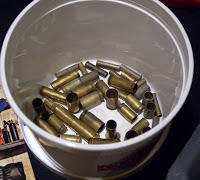
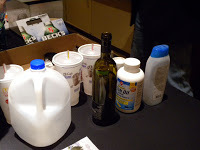
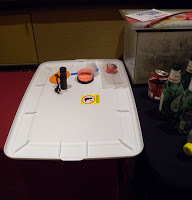
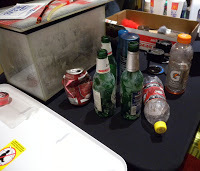
The quality of fingerprints is affected by environment. Here in Colorado, it's a very dry climate, and since fingerprints are mostly water, we don't leave as many as we would in a more humid environment. Also, as people age, their skin tends to dry out and become more brittle, so again, the quality of prints deteriorates. On the flip side, prints of prepubescent children don't last long on surfaces.
Most law enforcement officers are trained to lift prints using black powder, but the more sophisticated tests are done back in the lab.
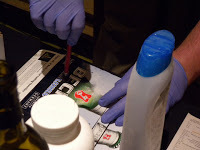
Once Tom filled us in on background information, he turned us loose on his collection of things to print, and tools for printing. We had access to black fingerprint powder, magnetic powder, powders that fluoresced, and a collection of things he'd fumed with super glue. We discovered relatively quickly that he wasn't kidding. It wasn't easy for us to find prints, even when we were the ones making them and knew exactly where they were. To get my prints on a plastic fast-food cup, I first made sure I touched my fingers to my face (to pick up extra oils), and then planted them firmly on the cup. After that, Tom lifted them using tape and put them on a card.
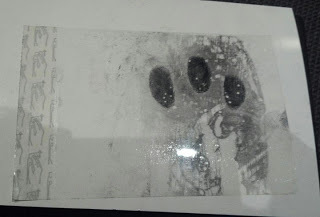
The other important piece of takeaway information was that law enforcement is always looking to create a triangle, connecting the victim, the suspect, and the crime scene.
The second workshop was about forensics in 1875. Quite a difference. I'll have my recap of that one another time.
Like this post? Please share by clicking one of the links below.
Continuing with workshop recaps from the Pikes Peak Writers Conference.
 There were two workshops on forensics, both given by retired forensics expert, Tom Adair. (And, he's going to be my guest on May 8th). Both were "hands on" which made a great change from sitting and taking notes.
There were two workshops on forensics, both given by retired forensics expert, Tom Adair. (And, he's going to be my guest on May 8th). Both were "hands on" which made a great change from sitting and taking notes. The first was about fingerprinting. (And although the workshop was hands on, he did begin with some facts.)
Fingerprints are unique and permanent (with very few exceptions, such as burns. They're established in the second trimester, pre-birth. In addition to fingerprints, all dermal ridge prints are unique to the individual (feet, toes, palms, etc.)
Contrary to what we might believe from television, prints are NOT everywhere. And, not finding someone's prints on an object doesn't mean the person didn't touch it. Finger marks are more common, but they're not usable for identification. Probably fewer than 10% of fingerprints found at a crime scene are identifiable to someone. It's not likely you'll get prints from bullet casings.




The quality of fingerprints is affected by environment. Here in Colorado, it's a very dry climate, and since fingerprints are mostly water, we don't leave as many as we would in a more humid environment. Also, as people age, their skin tends to dry out and become more brittle, so again, the quality of prints deteriorates. On the flip side, prints of prepubescent children don't last long on surfaces.
Most law enforcement officers are trained to lift prints using black powder, but the more sophisticated tests are done back in the lab.

Once Tom filled us in on background information, he turned us loose on his collection of things to print, and tools for printing. We had access to black fingerprint powder, magnetic powder, powders that fluoresced, and a collection of things he'd fumed with super glue. We discovered relatively quickly that he wasn't kidding. It wasn't easy for us to find prints, even when we were the ones making them and knew exactly where they were. To get my prints on a plastic fast-food cup, I first made sure I touched my fingers to my face (to pick up extra oils), and then planted them firmly on the cup. After that, Tom lifted them using tape and put them on a card.

The other important piece of takeaway information was that law enforcement is always looking to create a triangle, connecting the victim, the suspect, and the crime scene.
The second workshop was about forensics in 1875. Quite a difference. I'll have my recap of that one another time.
Like this post? Please share by clicking one of the links below.
Published on April 26, 2012 04:00
April 25, 2012
What's Cooking Wednesday - Cucumber Radish Salad
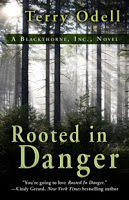
Before this week's recipe, I thought I'd mention that ROOTED IN DANGER is available for pre-order. I'm also giving away a copy through Goodreads (link is the same as above). Note: If you pre-order the book through Amazon or Barnes & Noble, the actual 'release' date is an approximation. They'll be filling orders, but might not have the book in stock on that exact date. They'll send you an email telling you it's delayed and they'll also give you the option of cancelling your order. Please don't. It'll get to you. And if you have a library card, you can ask your library to order the book. That gives you a free read and keeps the publisher happy. If you need to provide it, the ISBN is 978-1-4328-2585-0
And, onto the recipe!
I was looking for something to do with the extra bunch of radishes I bought for Passover, and found this recipe. Yummy. And quick.

Cucumber Radish Salad
Ingredients:
1/4 c fresh lime juice
1 T sugar
2 Cucumbers, thinly sliced (I used 1 big one, peeled)
1 bunch radishes, thinly sliced
1/3 c golden raisins (I used regular, since I didn't have golden)
Instructions:
In a small bowl, mix lime juice and sugar.
In a medium bowl, combine cucumbers and radishes. (I sliced everything in the food processor) Pour dressing over. Mix gently. Sprinkle raisins on top. (I just mixed them all in together). Let the mixture stand for a while for flavors to combine. Recipe said to serve at room temperature, but leftovers are fine chilled.
Like this post? Please share by clicking one of the links below.
Published on April 25, 2012 04:00
April 24, 2012
Magic and Science, Wizards and Physics
Today my guest at Terry's Place is Karen McCullough. Karen is the author of ten mystery, paranormal, fantasy, and romance novels. Her hardcover mystery, A Gift for Murder, will be released in mass market paperback in June from Harlequin's Worldwide Mystery imprint; several of her novels are now available in Kindle, Nook and other formats from Smashwords.
According to science fiction author Arthur C. Clarke, “Any sufficiently advanced technology is indistinguishable from magic.” I’ve always been fascinated by that suggestion. It doesn’t take much imagination to figure out why that’s true, and we’ve seen it in action often enough when more technologically developed cultures first come into contact with more primitive ones.
The truth is that for most of us a lot of the technology we use today seems almost impossible. As a former computer programmer and IT person, I’ve taken apart and put back together my share of computers, but in fact my iPhone still seems a big magical to me.
A riff on that idea formed the basis of my book, Magic, Murder and Microcircuits.
If an advanced technology is indistinguishable from magic, why couldn’t what we call magic now actually be a technology that we don’t really understand?
Which led me to wonder, what kind of technology might that be?
There are plenty of options, including summoning intervention from outside sources (outside this universe, this dimension, some other plane of being), an invisible force of some kind that magic users can see or generate, or something so far out and different we can’t even contain the idea of what it might be.
The idea that interested me most was a version of the second, the invisible force, but I wanted to relate it to something that most of us are at least vaguely familiar with. In this book, I posit that magic is a kind of subatomic psychokinesis (the ability to move objects using just the mind). My wizards, of whom only a small number are actually strong enough to do anything useful with it, are psychokinetics who can view and move things on a microscopic level, but can do a lot of it on a scale that lets them do things that look like magic to everyone else.
One of the things I like about this system is that it imposes its own rules and limits on the characters. Because a wizard expends energy in doing mental/physical work, they can only do so much of it at a time before exhausting themselves, and they have to eat a lot to refuel.
As with most skills, they also have to be trained in how to use the power, and it’s a truly impersonal force that can be used for good or evil.
Using this system, wizards have to take into consideration the basic laws of physics. The more mass you try to move, the more energy it takes. They can do a lot by shaping gas molecules in air or pushing them in certain directions, diverting electrons, etc., but there are things they can’t do. They can’t fly; they can’t summon fire or throw fireballs unless there is already a fire in the vicinity; they can’t vanish into thin air; and while a strong mage can divert bullets, if one hits him he’s going to be just as injured as anyone else. They can only use the matter and forces that are available to them, and their abilities are constrained by distance and other environmental factors.
There are lots of possibilities and choices to make when creating a system of magic. They don’t have to be based in any kind of reality as this one is. In fact there are few rules about magic systems other than that you do have to have rules and they have to be applied consistently.
To read more about how this system works out in the novel, you can get Magic, Murder and Microcircuits for Kindle, for Nook, and in other formats from Smashwords for just $1.99. Read more about this book, including an extended excerpt, or any of Karen's other books at her website, http://www.kmccullough.com .
Like this post? Please share by clicking one of the links below.
According to science fiction author Arthur C. Clarke, “Any sufficiently advanced technology is indistinguishable from magic.” I’ve always been fascinated by that suggestion. It doesn’t take much imagination to figure out why that’s true, and we’ve seen it in action often enough when more technologically developed cultures first come into contact with more primitive ones.
The truth is that for most of us a lot of the technology we use today seems almost impossible. As a former computer programmer and IT person, I’ve taken apart and put back together my share of computers, but in fact my iPhone still seems a big magical to me.
A riff on that idea formed the basis of my book, Magic, Murder and Microcircuits.
If an advanced technology is indistinguishable from magic, why couldn’t what we call magic now actually be a technology that we don’t really understand?
Which led me to wonder, what kind of technology might that be?
There are plenty of options, including summoning intervention from outside sources (outside this universe, this dimension, some other plane of being), an invisible force of some kind that magic users can see or generate, or something so far out and different we can’t even contain the idea of what it might be.
The idea that interested me most was a version of the second, the invisible force, but I wanted to relate it to something that most of us are at least vaguely familiar with. In this book, I posit that magic is a kind of subatomic psychokinesis (the ability to move objects using just the mind). My wizards, of whom only a small number are actually strong enough to do anything useful with it, are psychokinetics who can view and move things on a microscopic level, but can do a lot of it on a scale that lets them do things that look like magic to everyone else.
One of the things I like about this system is that it imposes its own rules and limits on the characters. Because a wizard expends energy in doing mental/physical work, they can only do so much of it at a time before exhausting themselves, and they have to eat a lot to refuel.
As with most skills, they also have to be trained in how to use the power, and it’s a truly impersonal force that can be used for good or evil.
Using this system, wizards have to take into consideration the basic laws of physics. The more mass you try to move, the more energy it takes. They can do a lot by shaping gas molecules in air or pushing them in certain directions, diverting electrons, etc., but there are things they can’t do. They can’t fly; they can’t summon fire or throw fireballs unless there is already a fire in the vicinity; they can’t vanish into thin air; and while a strong mage can divert bullets, if one hits him he’s going to be just as injured as anyone else. They can only use the matter and forces that are available to them, and their abilities are constrained by distance and other environmental factors.
There are lots of possibilities and choices to make when creating a system of magic. They don’t have to be based in any kind of reality as this one is. In fact there are few rules about magic systems other than that you do have to have rules and they have to be applied consistently.
To read more about how this system works out in the novel, you can get Magic, Murder and Microcircuits for Kindle, for Nook, and in other formats from Smashwords for just $1.99. Read more about this book, including an extended excerpt, or any of Karen's other books at her website, http://www.kmccullough.com .
Like this post? Please share by clicking one of the links below.
Published on April 24, 2012 04:37
April 23, 2012
Pikes Peak Writers Conference 1. Publishing
What I'm reading: contest entry #4 of 4
[image error] I'm writing this shortly after walking in the door from the Pikes Peak Writers Conference. It, like all conferences, was exhausting, but in a good way. I'll be recapping the highlights. And, apologies in advance, but Blogger has had an issue with posts going up when they're scheduled in advance. Much as I love you all, I'm not getting up in the wee hours to keep to my normal posting schedule. If this hasn't posted when I get up, I'll do it manually, but bear with me for any deviations from my normal posting time. Not only that, but they've changed their interface, so there's yet another learning curve for me. I'm thinking I'll be over at WordPress before too long.)
First, for anyone interested, dinner with Robert Crais was FANTASTIC. I have no clue what I ate, but the conversation was a delight (as was the wine). I know I'm a writer, and consider myself a 'regular' person, but even so, there's something "larger than life" that kicks in when meeting a REAL writer. But he's a 'regular' person, too. At his keynote address, he shared emails from readers who took him to task on everything from grammar to accusing him of padding his books by having blank pages between chapters.
Over the course of the conference, I attended 3 workshops on the publishing industry, and it was also a frequent topic of discussion over meals, and from keynote speakers. I'm going to hit the highlights rather than recap each individual workshop.
Mark Coker, CEO of Smashwords, spoke not only about his publishing company, but also about publishing in general.
Until recently, you weren't considered a "real" author unless a big-name publisher bought your book. With e-publishing, it's possible to succeed on your own, and perhaps make more money. But don't count on it. If that's why you're writing, you're setting yourself up for disappointment.
The most important part of success in publishing is: WRITE A GOOD BOOK. (And this includes making sure it's well-edited.)
Second: have a good cover. Your cover needs to convey what kind of book it is. A romance cover should look very different from a thriller cover. Readers who are misled will be disappointed, are likely to leave bad reviews, and not buy more of your books.
Coker shared some statistics gleaned primarily from Smashwords books sold at the Apple iStore. As far as making money, the lowest yield are from books priced at 99 cents to $1.99. The sweet spot for profit seems to be in the $2.99 - $5.99 range. (Maybe I should raise some of my prices???)
Although people once thought e-books were a way to publish short stories or novellas, statistically, the best-selling e-books are about 110-120 thousand words.
If you're an indie publisher, odds are you're not going to do well in print.
**(Personal experience substantiates this for me, which is why I haven't rushed to put my backlist back into print after I've published them digitally. I've sold about 1500 digital copies of my two original books, and 8 print copies.)
From other speakers, including Donald Maass, Jeffery Deaver, and Robert Crais: Writers are storytellers, and have been since the days of the cave man. It's all about telling the story, not the medium in which it's delivered. Stone tablet, parchment scroll, typed on a manual typewriter, printed, electronic, audio—it doesn't matter. The platform changes, but publishing will survive.
Writers can change people's lives. We can make them think, laugh, cry, and bring them a way to escape their everyday lives. In addition to the critical e-mails Crais received, he shared another from a soldier who said Crais's books saw him through his deployment.
As writers, we should be looking forward, writing books that the next generation will read and remember.
More posts to come, including some great sessions on forensics, but tomorrow, my guest is Karen McCullough, who's talking about magic and science in fiction.
Like this post? Please share by clicking one of the links below.
[image error] I'm writing this shortly after walking in the door from the Pikes Peak Writers Conference. It, like all conferences, was exhausting, but in a good way. I'll be recapping the highlights. And, apologies in advance, but Blogger has had an issue with posts going up when they're scheduled in advance. Much as I love you all, I'm not getting up in the wee hours to keep to my normal posting schedule. If this hasn't posted when I get up, I'll do it manually, but bear with me for any deviations from my normal posting time. Not only that, but they've changed their interface, so there's yet another learning curve for me. I'm thinking I'll be over at WordPress before too long.)
First, for anyone interested, dinner with Robert Crais was FANTASTIC. I have no clue what I ate, but the conversation was a delight (as was the wine). I know I'm a writer, and consider myself a 'regular' person, but even so, there's something "larger than life" that kicks in when meeting a REAL writer. But he's a 'regular' person, too. At his keynote address, he shared emails from readers who took him to task on everything from grammar to accusing him of padding his books by having blank pages between chapters.
Over the course of the conference, I attended 3 workshops on the publishing industry, and it was also a frequent topic of discussion over meals, and from keynote speakers. I'm going to hit the highlights rather than recap each individual workshop.
Mark Coker, CEO of Smashwords, spoke not only about his publishing company, but also about publishing in general.
Until recently, you weren't considered a "real" author unless a big-name publisher bought your book. With e-publishing, it's possible to succeed on your own, and perhaps make more money. But don't count on it. If that's why you're writing, you're setting yourself up for disappointment.
The most important part of success in publishing is: WRITE A GOOD BOOK. (And this includes making sure it's well-edited.)
Second: have a good cover. Your cover needs to convey what kind of book it is. A romance cover should look very different from a thriller cover. Readers who are misled will be disappointed, are likely to leave bad reviews, and not buy more of your books.
Coker shared some statistics gleaned primarily from Smashwords books sold at the Apple iStore. As far as making money, the lowest yield are from books priced at 99 cents to $1.99. The sweet spot for profit seems to be in the $2.99 - $5.99 range. (Maybe I should raise some of my prices???)
Although people once thought e-books were a way to publish short stories or novellas, statistically, the best-selling e-books are about 110-120 thousand words.
If you're an indie publisher, odds are you're not going to do well in print.
**(Personal experience substantiates this for me, which is why I haven't rushed to put my backlist back into print after I've published them digitally. I've sold about 1500 digital copies of my two original books, and 8 print copies.)
From other speakers, including Donald Maass, Jeffery Deaver, and Robert Crais: Writers are storytellers, and have been since the days of the cave man. It's all about telling the story, not the medium in which it's delivered. Stone tablet, parchment scroll, typed on a manual typewriter, printed, electronic, audio—it doesn't matter. The platform changes, but publishing will survive.
Writers can change people's lives. We can make them think, laugh, cry, and bring them a way to escape their everyday lives. In addition to the critical e-mails Crais received, he shared another from a soldier who said Crais's books saw him through his deployment.
As writers, we should be looking forward, writing books that the next generation will read and remember.
More posts to come, including some great sessions on forensics, but tomorrow, my guest is Karen McCullough, who's talking about magic and science in fiction.
Like this post? Please share by clicking one of the links below.
Published on April 23, 2012 04:10
April 20, 2012
Friday Field Trip - Flowers
Up here in the mountains, we don't have much in the way of pretty 'flower shop' flowers. But my mom sent some of her favorite flower shots to share. Enjoy! Spring is here.








Like this post? Please share by clicking one of the links below.








Like this post? Please share by clicking one of the links below.
Published on April 20, 2012 04:00



